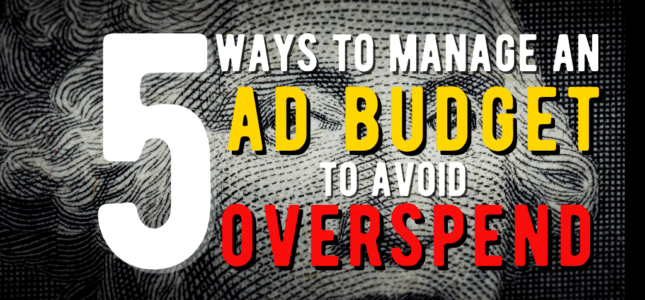Creating, managing and sticking to a digital advertising budget isn’t something that everyone enjoys doing or successfully achieves, despite how important it is to most businesses. Right now, with the cost-of-living crisis at the forefront of many people’s minds, getting the best value for money from all of your outgoings has become a priority and of course, sticking to budget and NOT overspending.
An initial reaction to managing spending in your business can be to cut costs everywhere. However, digital ad spend is one area that requires a lot of thought before you begin trimming your budget and reducing your campaigns. If you absolutely have to lower your budget or, its essential you stick to your existing planned spend, then here are some tips to help you make every penny count as you drive forward with your business in these uncertain times.
1. Identify Your Key Objectives

Rather than using a scattergun approach where you try out a few different strategies for a variety of areas of your business, identifying the key objectives of any digital advertising campaigns or content development is great way to focus your budget.
One good question to ask yourself is whether your business is in need of brand awareness or brand loyalty. Once you know the answer, you can then opt for prioritising sales or branding in your online ads. Then, if you commit to one and achieve success, it might be possible to add the second into your strategy while staying on top of costs.
2. Use The 70-20-10 Rule

The 70-20-10 rule can help you think more clearly about prioritising your digital advertising needs. This formula relates to the type of strategy and also products or services you should focus on promoting.
The biggest chunk of your advertising budget – 70% – should be spent on “now” advertising. That includes using existing strategies you already know work well for your business and also, to advertise products and services that are already available. This means you are committing most of your budget to an area of proven success that should deliver that ROI you’re looking for.
Your 20% should be for the “next” and upcoming strategies and products or services. These are options you have already tested a little but are still in the process of introducing. That way, if things don’t go to plan, then it’s a smaller proportion of your budget that is at risk.
Meanwhile, the remaining 10% is for the future, testing new strategies you haven’t previously used and possibly finding out what your customer reaction could be to prospective services and products.
3. Demand-Based Advertising

If you don’t have enough historic data to help you decide which strategies are worth your investment, one area that typically works well and can be easily managed, is demand-based advertising, which includes search or PPC.
This option ensures your digital adverts are shown to potential customers who are already searching for the goods or services you offer. Another benefit is that you only pay if the user clicks on your digital ad, while the ability to set a budget or limit is also helpful.
If you’ve previously used PPC but found it wasn’t as successful as you had expected, a PPC audit across either one or all of your social media platforms can prove useful. While this may be another initial cost if you choose to instruct an outside professional to conduct this for you, in many cases it can prove worthwhile due to the improvement in results from any PPC campaign that follow on from the audit.
4. Content Development

We all know that content remains an essential part of any company’s online presence and digital advertising activities. However, knowing what type of content best resonates with your customer base isn’t always easy to decipher. With that in mind, a little market research or diving into any previous user data can help here.
Once you have a better understanding of the type of content that drives users further through your sales funnel, then focus your budget and time on that. It’s helpful to remember that if video is a popular option with your users, thanks to the rise of DIY content online you no longer need to spend as much as you might think to secure the results you want.
5. Narrow Your Social Media Focus
 Although having a wide reach across digital and social media can help boost brand awareness and sales, including all channels comes at a cost. It can therefore be useful to narrow your social media platform use to two or three from a broader strategy.
Although having a wide reach across digital and social media can help boost brand awareness and sales, including all channels comes at a cost. It can therefore be useful to narrow your social media platform use to two or three from a broader strategy.
Once again, it will be useful to review your existing user and advertising data to get a clear picture of which platforms work best for your business. Then, armed with those details you can drop one or two options – even if it’s just a temporary change – and focus your budget on that smaller pool, which should help you manage your costs and also secure value for money and the right ROI.
These aren’t the only ways to manage your digital advertising budget during times of uncertainty. However, by using even just one or two of these options you will become more aware of where your investment is going and how effective it is, ensuring closer management of your advertising out-goings.
What are you thoughts or tips on how to control and manage your spend? Comment below.

